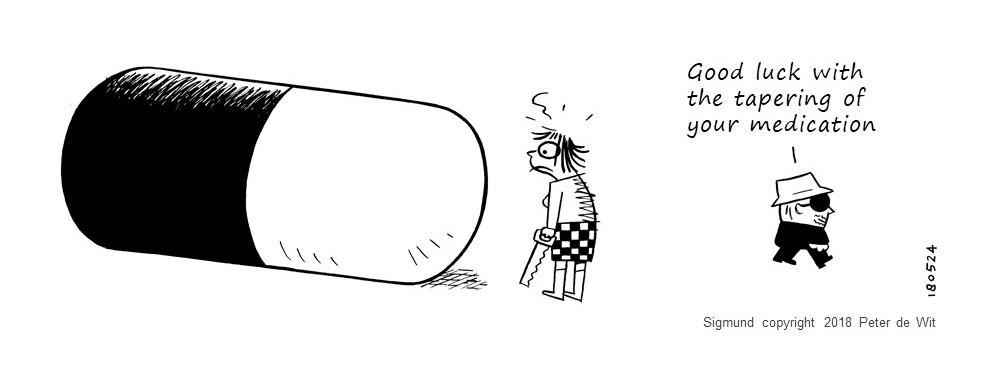An observational study published in the journal Psychosis shows that antidepressant withdrawal symptoms can be minimised or avoided by using prepackaged medication in tapering strips
Peter Groot and Jim van Os.
Antidepressant users who have come to the end of treatment and wish to stop can suffer withdrawal symptoms, even when following their doctor’s advice. In some cases, these withdrawal symptoms can be so severe that they prevent the user from stopping their medication. This can often be problematic for the patient and can result in unnecessary prescriptions, additional cost for health services and potential long-term health issues.
Tapering medication makes safe withdrawal possible by utilising pills of small dosages to make much smaller dosage reductions than can be achieved using standard registered dosages. This approach makes tapering easy for the antidepressant user and the doctor. The study shows that more patients are successful using tapering strips when compared to those who had tried to reduce using other methods and allows patients who have previously tried and failed to withdraw the opportunity to succeed in coming off their antidepressant medication.
What is tapering medication?
Tapering medication is prepackaged in tapering strips which make it easy for the patient to reduce without needing to follow complicated instructions. Furthermore the strips make it easy for doctors to prescribe personalised tapering schedules for their patients. A tapering strip consists of 28 sachets on a roll, with each sachet providing the medication for a single day. The daily dosage in each sachet is a little less or equal to that of the previous day. A doctor, psychiatrist or therapist can prescribe tapering schedules tailored to and in consultation with the patient in a shared decision-making approach. Using currently available standard registered dosages, gradual tapering is often difficult and, in some cases, impossible to achieve. Due to these limitations, current tapering guidelines are also difficult to follow for both the prescriber and the patient.
About the study
The study reviewed 1121 questionnaires completed by patients who wanted to withdraw from their antidepressant medications. The majority (75%, n = 895) wanted to taper off completely. Of these, 62% (n = 692) had previously made one or more tapering attempts. Almost everyone (97%) had suffered withdrawal symptoms during these earlier attempts, which were rated as very severe by 49% (7 on a scale of 1-7). The duration of antidepressant use varied from less than a year to more than 30 years (median: 2-5 years).
A comparison of withdrawal with or without tapering medication
All patients were asked about their tapering experience, using a scale from 1-7, where 1 = very good and 7 = very bad. In addition, they were asked if they had experienced withdrawal symptoms on a 1-7 scale, where 1 = not at all and 7 = very much. Patients were also asked to rate their previous attempts to withdraw, therefore making a comparison possible between tapering medication and other methods.
Study findings
The main results of the study are that, of the 895 people who used tapering strips to taper the antidepressant they used:·
71% (n = 636) succeeded in a median time of 56 days (2 tapering strips).
13% (n = 192) did not complete the taper, 8% (n = 67) because they were still tapering, 4% (n = 39) due to withdrawal symptoms and 6% (n = 53) due to relapse (defined as the recurrence of complaints such as anxiety or depression).
The results of this study show that, for patients who had previously tried and failed to withdraw, the use of tapering medication in tapering strips could enable them to withdraw successfully.
Tapering medication enables shared decision making
For patients who wish to withdraw, attempting to taper using standard registered doses increases the risk of withdrawal symptoms, leading to an increased risk of withdrawal failure and unnecessary long-term antidepressant use. Allowing patients and doctors to work together to define personalised tapering schedules has been shown to reduce withdrawal symptoms and increase the chances of success. By doing this, doctors can focus on patient recovery and more easily distinguish between withdrawal symptoms and relapse, which is important in avoiding the unnecessary prescribing of antidepressant medications.
Applying tapering principles to other medications
The results of this study are relevant for people using other psychotropic medications such as antipsychotics or benzodiazepines. This is important for people with psychosis who will often be taking multiple medications. The use of tapering medication in tapering strips offers the opportunity to make safe, gradual dosage adjustments while minimising unpleasant withdrawal symptoms even in those patients who are taking multiple medications. The use of tapering strips enables a level of flexibility and personalisation that is simply not achievable using conventional standard registered dosages.
Dr. Peter C. Groot is a researcher and expert by experience at the User Research Center of Maastricht University and volunteer at the Cinderella Therapeutics Foundation. Prof. Jim van Os is Chairman of the Brain Division at the Utrecht University Medical Center. Contact: p.c.groot@maastrichtuniversity.nl
References
Antidepressant tapering strips to help people come off medication more safely
Peter C. Groot & Jim van Os. Psychosis, 2018, doi.org/10.1080/17522439.2018.1469163
See also:
Tapering Strips Help People Discontinue Antidepressants
Madinamerica, 24 May 2018

